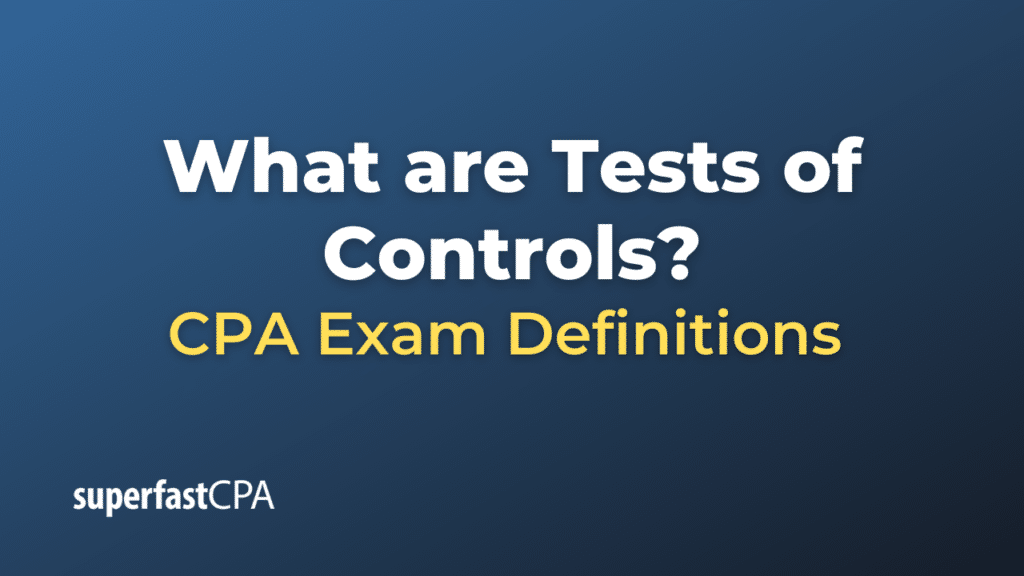Tests of Controls
“Tests of controls” are procedures used by auditors in the process of evaluating the effectiveness of a company’s internal controls. Internal controls are the policies, procedures, and mechanisms put in place by an organization to ensure the reliability of financial reporting, efficient operations, and compliance with laws and regulations. These controls also aim to prevent or detect errors and fraud.
When auditors perform a financial statement audit, they want to assess the risk that material misstatements might be present in the financial statements. The effectiveness of the company’s internal controls can significantly influence this risk. If controls are strong and effective, auditors may rely on them, which could reduce the amount of substantive testing they might otherwise need to perform.
Tests of controls typically include the following procedures:
- Inquiries: Asking relevant personnel about the controls in place and how they are implemented.
- Observation: Directly watching the process or control being performed.
- Inspection: Reviewing documentation, such as sign-offs, reconciliations, or other evidence that a control has been performed.
- Reperformance: The auditor independently executes the control to verify it’s functioning as intended.
- Walkthroughs: Tracing a transaction from start to finish to ensure all control points are effectively operating.
After performing tests of controls, auditors will:
- Assess Effectiveness: Determine whether the controls are effective and whether they are being consistently applied.
- Decide on Subsequent Audit Procedures: If controls are deemed effective, the auditor might decide to rely on them and perform fewer substantive procedures. Conversely, if controls are not effective, the auditor might decide to perform more detailed substantive tests.
- Document Findings: Auditors will document their understanding of the controls, the tests they’ve performed, and their findings. This documentation becomes a crucial part of the audit working papers.
It’s important to note that the extent and nature of tests of controls will vary depending on the audit approach, the nature of the company’s operations, and the quality of its internal control environment.
Example of Tests of Controls
Let’s explore tests of controls with a hypothetical scenario:
Scenario:
Suppose an auditor is auditing the financial statements of a company called “TechBrite,” which manufactures electronic devices. One critical account for TechBrite is its inventory. Proper recording and valuation of inventory are vital for accurate financial reporting. TechBrite has an internal control process where all inventory removals are documented and approved by a supervisor.
Tests of Controls for Inventory Removal:
- Inquiries: The auditor speaks with the warehouse manager about the process. The manager explains that any time inventory is removed, a removal slip must be filled out, and then it’s authorized by a supervisor, who signs the slip. This is to prevent unauthorized or undocumented removal of inventory.
- Observation: The auditor spends a day in the warehouse watching the inventory removal process. They observe several removals and note that in each case, the process described by the manager is followed.
- Inspection: The auditor randomly selects 30 removal slips from the past year and checks for the supervisor’s signature to confirm that the control was followed.
- Reperformance: The auditor identifies an inventory item to be removed and goes through the removal process themselves, filling out a removal slip and then seeing if a supervisor reviews and approves it.
- Walkthrough: The auditor selects a specific inventory item, traces its removal slip, and follows the whole process from the initiation of the removal to its recording in the accounting system, ensuring all controls are applied.
Outcome:
From the tests of controls:
- The inquiries and observations confirm the existence and consistent application of the control.
- The inspection of removal slips shows that 29 out of 30 slips had appropriate supervisor approval. One was missing the signature.
- The reperformance and walkthrough procedures further verify the control’s existence and application.
Given these findings, the auditor determines that while the control is mostly effective, there is a minor lapse. This assessment might mean the auditor would conduct some additional substantive testing regarding inventory removals but might still rely somewhat on the control, given its general effectiveness.
This example illustrates how tests of controls give auditors insight into the effectiveness of a company’s internal processes and influence the nature and extent of further audit procedures.













